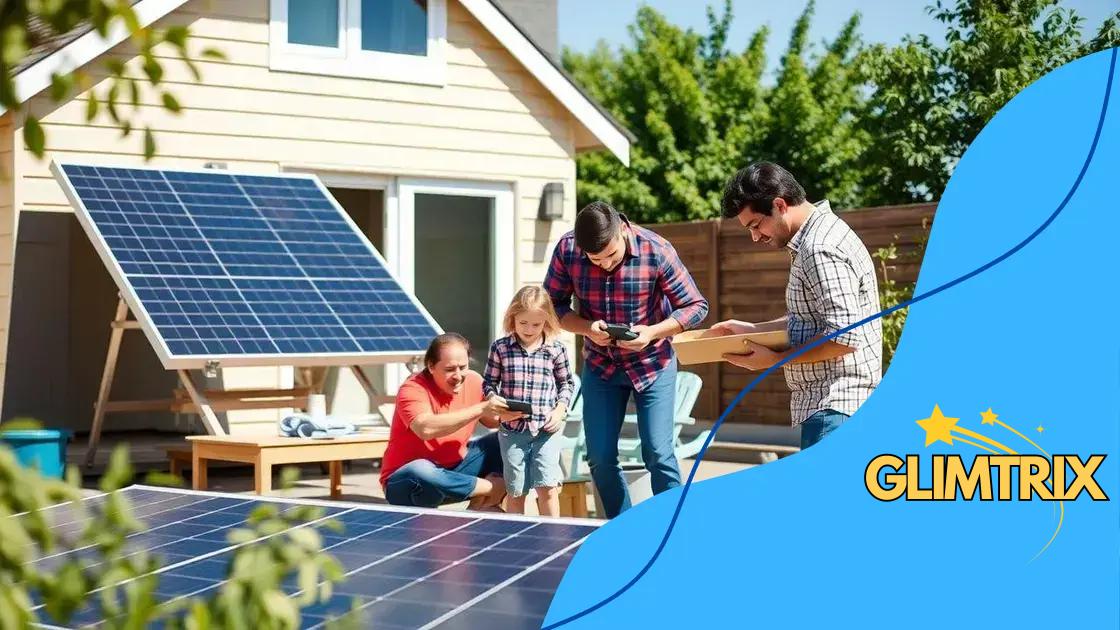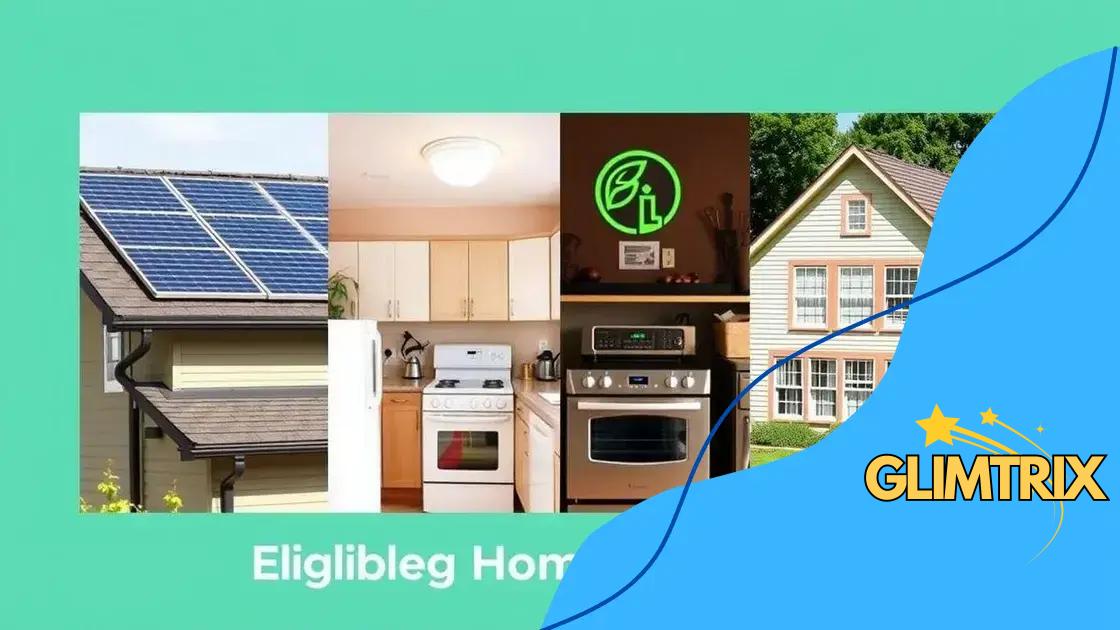Federal tax credits for green home improvements: save money now

Federal tax credits for green home improvements provide significant savings for homeowners who make energy-efficient upgrades, including solar panels and energy-efficient appliances, while effectively reducing their tax liabilities.
Federal tax credits for green home improvements can make a substantial difference in how much you spend while enhancing your home. Have you ever thought about how these credits could help you save money on energy efficiency upgrades? Let’s dive into the details.
Understanding federal tax credits
Understanding federal tax credits can seem overwhelming at first, but it’s an avenue that can help you save significantly on home improvements. These credits are designed to encourage homeowners to make energy-efficient upgrades, which can save money both on the upfront cost of improvements and on long-term energy bills.
What are federal tax credits?
Federal tax credits are reductions in the amount of tax you owe to the government. Unlike deductions, which only reduce taxable income, credits offer a dollar-for-dollar reduction of your tax bill. This means they can provide substantial savings when you invest in certain home improvements aimed at efficiency and sustainability.
Types of credits available
The federal government offers various tax credits for homeowners making energy-efficient upgrades:
- Solar energy systems: Installing solar panels can qualify you for the solar investment tax credit (ITC).
- Energy-efficient windows: Replacing old windows with energy-efficient ones can also earn you a credit.
- Insulation upgrades: Improving your home’s insulation can make it more energy-efficient, qualifying you for additional credits.
Understanding the specifics of these credits can help you plan your next home project. For example, residential energy efficiency packages can qualify you for substantial tax benefits under the law. You just need to keep track of the expenses related directly to the improvements made.
To ensure that you receive the full benefits, keeping documentation is key. You should have receipts and any certification from manufacturers to substantiate your claims. This way, when tax time rolls around, you’ll be ready to reduce your tax obligations significantly.
How to stay updated on credits
Tax laws can change frequently, so it’s important to stay informed about the latest federal tax credits available. Websites dedicated to energy efficiency and federal tax information provide reliable updates, ensuring you don’t miss out on potential savings.
Certainly, understanding federal tax credits opens up a new world of possibilities for homeowners looking to save money and increase the value of their homes through smart, energy-efficient improvements.
Eligibility requirements for homeowners
Understanding the eligibility requirements for homeowners looking to benefit from federal tax credits is essential. These requirements ensure that only qualified improvements and homeowners gain access to these valuable savings. Knowing these guidelines can simplify the process and maximize your potential tax benefits.
General eligibility criteria
To qualify for federal tax credits, homeowners generally must meet some basic criteria. Primarily, the improvements made to the home must be permanent and intended to enhance energy efficiency. Additionally, the property must be your primary residence.
Specific requirements for common credits
Different tax credits may have unique requirements:
- Solar energy systems: Your solar panels must meet specific performance standards laid out by the IRS.
- Window replacements: The windows installed should meet or exceed energy efficiency ratings set by ENERGY STAR.
- Insulation improvements: Only qualified insulation products will be eligible, which are listed by federal guidelines.
Homeowners must also stay aware of purchase eligibility based on installation dates, as many credits are time-sensitive. Keeping track of these details can ensure you don’t miss out on savings.
Moreover, it’s useful to have documentation ready, such as receipts and certifications regarding the energy efficiency of the improvements. This can easily help validate your claims when filing your taxes.
In many cases, consult with a tax professional or financial advisor to navigate eligibility more effectively. This step can uncover additional opportunities for savings and ensure compliance with regulations.
Types of eligible green home improvements

When exploring types of eligible green home improvements, it’s important to understand what qualifies for federal tax credits. Numerous options exist that not only enhance energy efficiency but also contribute to a healthier environment.
Energy-efficient appliances
Upgrading to energy-efficient appliances is a great way to save on energy bills while improving your home. These appliances are designed to use less electricity and water, making them cost-effective choices.
Solar energy systems
Installing solar panels allows you to harness the sun’s energy. This renewable energy solution can significantly reduce your electricity costs and qualify for substantial tax credits.
Insulation and sealing
Enhancing your home’s insulation is another valuable upgrade. Proper insulation keeps your home warm in winter and cool in summer, reducing the need for heating and cooling systems.
- Air sealing: Sealing gaps and cracks in your home improves energy efficiency by preventing heat loss.
- Insulation materials: Opting for high-quality insulation can meet the requirements set by energy standards.
- Windows and doors: Replacing old windows with energy-efficient ones can also qualify as eligible improvements.
Landscaping plays a role too. Planting trees or other greenery can provide natural shade, reducing cooling costs in the summer. Using native and drought-resistant plants minimizes water use and enhances biodiversity.
These improvements not only contribute to sustainability but can significantly enhance the value and comfort of your home. Remember, staying informed about federal guidelines ensures you make the most of available credits and rebates.
Steps to apply for tax credits
Applying for federal tax credits can be straightforward if you follow some clear steps. Understanding these steps can help ensure that you maximize your savings and avoid common pitfalls during the application process.
1. Identify eligible improvements
The first step is to identify which of your home improvements are eligible for tax credits. Review the specific types of upgrades, such as solar energy systems, energy-efficient windows, and appliances that meet federal guidelines.
2. Gather documentation
Collect all necessary documentation related to your eligible improvements. This may include:
- Receipts: Keep receipts for all purchases related to your home improvements.
- Manufacturer certifications: Obtain any certifications proving that your upgrades meet federal standards.
- Tax forms: Familiarize yourself with the tax forms required to claim your credits.
Having everything organized will make your tax filing smoother and more efficient.
3. Complete the appropriate tax forms
Once you have identified your improvements and gathered your documentation, it’s time to complete the appropriate federal tax forms. Typically, this includes IRS Form 5695, which is specifically used to calculate your residential energy credits. Make sure to follow the instructions carefully.
4. File your taxes
When you are ready, file your taxes. You can do this electronically or through traditional mail. If you’re uncertain, consider consulting with a tax professional to ensure compliance and accuracy.
After filing, keep copies of all your documents and forms for your records. This is especially important if the IRS has questions about your claims in the future.
By following these steps, you can simplify the application process for home improvement tax credits and make the most of your energy-saving efforts.
Potential financial benefits of these credits
The potential financial benefits of federal tax credits for green home improvements can be significant. Homeowners can save money not only through direct reductions in their tax liabilities but also by increasing the overall energy efficiency of their homes.
1. Direct tax savings
One of the most immediate advantages is the direct savings on your taxes. By taking advantage of these credits, you can decrease your taxable income, which lowers your overall tax bill. For instance, if you spend $10,000 on energy-efficient upgrades and qualify for a tax credit of 30%, you can save $3,000 on your taxes.
2. Reduced energy costs
Investing in energy-efficient systems can lead to lower monthly utility bills. Over time, these savings can add up significantly. For instance, upgrading insulation or installing energy-efficient windows can reduce heating and cooling costs by a substantial percentage, helping your budget.
3. Increased home value
When you make green improvements, you may also boost your home’s value. Energy-efficient homes are often more desirable in the real estate market, leading to higher selling prices down the line. Buyers today are increasingly aware of energy-saving features and are willing to pay a premium for them.
- Lower operating costs: Homes with energy-efficient upgrades tend to have lower operating costs, making them more attractive to prospective buyers.
- Access to incentives: Some states and municipalities offer additional financial incentives for installing energy-efficient systems, enhancing the savings.
- Market appeal: A home with green features may have a competitive edge when listed for sale, shortening time on the market.
These credits and improvements can encourage homeowners to invest more in their properties while promoting sustainability. Ultimately, the financial benefits of taking advantage of these credits extend beyond just tax savings; they encompass a holistic approach to financially and environmentally sound living.
FAQ – Frequently Asked Questions about Federal Tax Credits for Green Home Improvements
What are federal tax credits for green home improvements?
Federal tax credits for green home improvements are financial incentives offered by the government to encourage homeowners to make energy-efficient upgrades to their properties.
How can I qualify for these tax credits?
To qualify, homeowners must meet certain eligibility requirements, such as making eligible improvements that enhance energy efficiency in their primary residence.
What types of improvements are eligible for tax credits?
Eligible improvements include solar energy systems, energy-efficient appliances, insulation upgrades, and certain types of windows and doors.
What steps do I need to take to apply for these credits?
To apply, you should identify eligible improvements, gather necessary documentation, complete the appropriate tax forms, and file your taxes either electronically or by mail.





